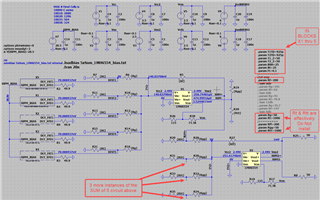Other Parts Discussed in Thread: LMH6703, LMH32401, OPA855, BUF802, LMH6654
Hello,
I am working on a summing circuit for the fast pulses produced by small Silicon Photo Multipliers. I refer here specifically to the ones from OnSemi (who bought SensL) that feature a Fast output terminal. Depending on a few different factors the rise time of the pulse is in the 200ps-300ps range.
The circuit has 5 inputs to the -ve input of the LMH6554; I fought for a while with some artifacts in the summed signal that I ultimately determined were due to the matching network I had on the +ve input - which, as it turns out wasn't really matching - so I've simply grounded the input and disconnected feedback from the V- output. And all seems OK, aside from a bit of offset on the output.
So, some questions:
- Is there any actual harm to the device from grounding an input?
- Are the inputs to this device internally symmetric - that is, could I just as easily sum at the +ve input and ground the -ve? I ask primarily because of possible advantages during layout.
- While I can use the Vcom terminal to to correct my lack of matching, the falling edge of the SiPM actually cross over "zero" - at least with the simulation model I have of the SiPM. If I want to offset the signal to deal with that cross over, I will have to introduce an offset at the input.
Would you say it is better to introduce that into summing node or actually add a matching resistor to ground at the +ve input and inject there? In my case I believe that matching resistor will be about 25 Ohms. - Of course I could use a non-differential amplifier but in my previous simulations attempts with other devices I was losing the rise time. That is, with something like the LMH6703 the rise time is closer to 1ns after the summing (though to be accurate it's actually the fall time due to the summing inversion). Can you think of any other non-differential amp that might do the job? I've been focused on current feedback amps so I'm not sure if there are other devices with new (to me) technology available now that are just as good for a summing amp.
Thanks
Miles




